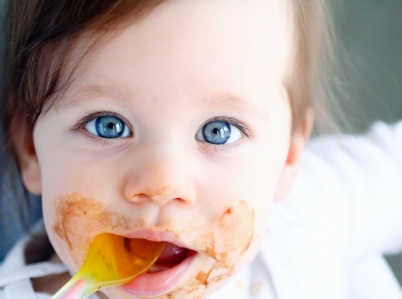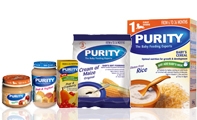Introducing Solids
Starting Solid Foods
 The time to start solid food depends on the infant's needs and readiness. Generally, infants need solids when they are large enough to need a more concentrated source of calories than formula. This need is recognized when an infant takes a full bottle and is satisfied, but then is hungry again in 2 or 3 hours. This typically occurs by the age of 6 months. Infants younger than this cannot easily swallow solid food, although some can swallow solids at younger ages if the food is placed on the back of the tongue. Some parents coax very young infants to eat large amounts of solid food in the hope that they will sleep through the night. This is unlikely to work, and forcing an infant to eat early can cause aspiration pneumonia and feeding problems later. Many infants take solids after a breastfeeding or bottle-feeding, which both satisfies their need to suck and quickly relieves their hunger.
The time to start solid food depends on the infant's needs and readiness. Generally, infants need solids when they are large enough to need a more concentrated source of calories than formula. This need is recognized when an infant takes a full bottle and is satisfied, but then is hungry again in 2 or 3 hours. This typically occurs by the age of 6 months. Infants younger than this cannot easily swallow solid food, although some can swallow solids at younger ages if the food is placed on the back of the tongue. Some parents coax very young infants to eat large amounts of solid food in the hope that they will sleep through the night. This is unlikely to work, and forcing an infant to eat early can cause aspiration pneumonia and feeding problems later. Many infants take solids after a breastfeeding or bottle-feeding, which both satisfies their need to suck and quickly relieves their hunger.
Infants develop food allergies or intolerance easier than older children or adults. If many different foods are given in a brief period, it is difficult to tell which one may have been responsible for a reaction. Because of this difficulty, parents should introduce new foods one at a time, no more than one new food a week. Once it is clear a food is tolerated, another one may be introduced.
Single-grain cereals are begun first, followed by fruits and vegetables. Meats, which are a good source of protein, should be introduced later, after about 7 months. Many infants initially reject meat.
The food should be offered on a spoon so that the infant learns the new feeding technique. By age 6 to 9 months, infants are able to grasp food and bring it to their mouths, and they should be encouraged to help feed themselves. However, babies easily choke on food in small, hard bits (such as peanuts, raw carrots, candies, and small crackers), so these foods should be avoided. Pureed home foods are less expensive than commercial baby foods and offer adequate nutrition.
Although infants enjoy sweet foods, sugar is not an essential nutrient and should be given only in small quantities, if at all. Sweetened dessert baby foods have no benefit for babies. Honey must be avoided during the first year because it may contain the spores of Clostridium botulinum, which are harmless to older children and adults but can cause botulism in infants.
From The Merck Manual of Medical Information – Second Home Edition, edited by Mark H. Beers. Copyright 2003 by Merck & Co., Inc., Whitehouse Station, NJ. See http://www.merck.com/mmhe/sec23/ch263/ch263e.html#sec23-ch263-ch263e-33 for full article. Accessed 3 July 2008.
First Solids
 Pediatricians recommend that babies should be started on some kind of solid food between the ages of four to six months based in individual development. Factors like a stable neck among others are used to decide whether a baby is ready to start eating or not. The reason why solids are introduced at this stage is because solid food allows for more calories to be inputted into the childs system which is what is required at this stage. It is also important that your baby learn the act of swallowing.
Pediatricians recommend that babies should be started on some kind of solid food between the ages of four to six months based in individual development. Factors like a stable neck among others are used to decide whether a baby is ready to start eating or not. The reason why solids are introduced at this stage is because solid food allows for more calories to be inputted into the childs system which is what is required at this stage. It is also important that your baby learn the act of swallowing.
These solid as they are called are not tough pieces of bread or chunks of chicken that your baby is expected to bite. The first meal that you offer your baby should ideally be a cereal mixed in breast milk or formula milk. Even though cereal manufacturers mention that you can mix the cereal in water, the use of milk helps in providing a familiar taste to the baby reducing the chances of it being rejected.
To start with, you should choose a rice cereal for your child. This is the preferred option since rice has almost a zero chance of being an allergen and is easily digested. Another cereal that is not likely to be an allergen is oatmeal. Once you have tried these with your baby, you can move on to other combinations like oatmeal and banana or rice and apple or oatmeal and mixed vegetables. There are options of exotic flavors like black currant to provide variety and excitement and amusement for the fledgling palette of your child.
Make sure that when you start making a cereal meal for you baby, you should ensure that the consistency is thin and almost fluid. You can gradually increase the cereal content and reduce the liquid added to obtain a thicker consistency as and when your baby shows signs of comfort with the food. Ensure that what you make is even and pasty and does not have lumps so that it is easy for the baby to swallow.
 Once your baby has taken to cereal and shown no allergies, you can start to introduce other foods. Keep in mind that your baby still does not have any teeth and it is a good idea to run anything that you want to feed your baby through a baby blending or mashing machine. A favorite fruit is banana that can easily be mashed, the slippery consistency of which is thoroughly enjoyed by babies. Make sure that you introduce a single new food at a time, giving about 2 weeks for each new addition to settle down before classifying it as an acceptable option.
Once your baby has taken to cereal and shown no allergies, you can start to introduce other foods. Keep in mind that your baby still does not have any teeth and it is a good idea to run anything that you want to feed your baby through a baby blending or mashing machine. A favorite fruit is banana that can easily be mashed, the slippery consistency of which is thoroughly enjoyed by babies. Make sure that you introduce a single new food at a time, giving about 2 weeks for each new addition to settle down before classifying it as an acceptable option.
Obviously, once the baby cuts teeth and has a nice set of pearly white milk teeth, you can start offering real solid food to your child.
Author: Kenneth Scott



